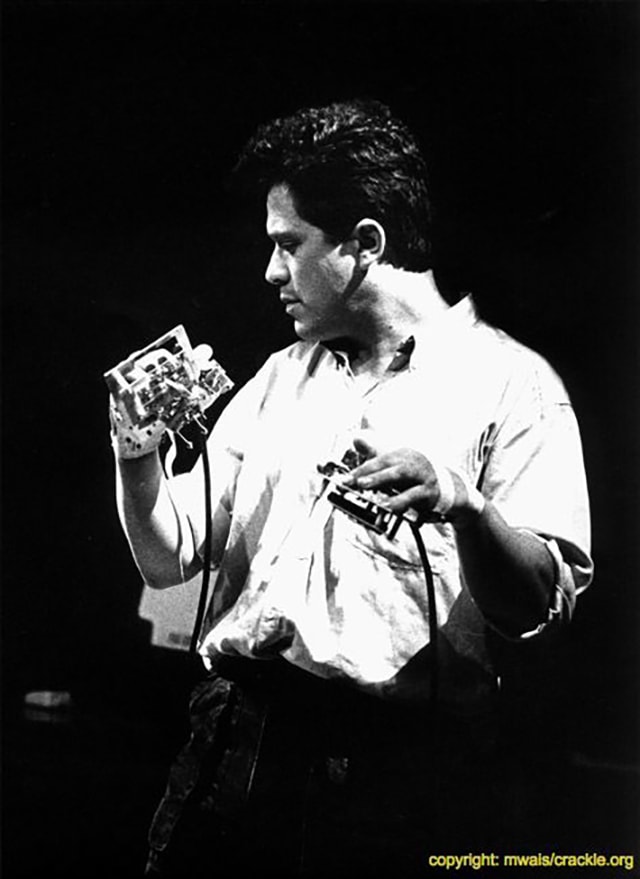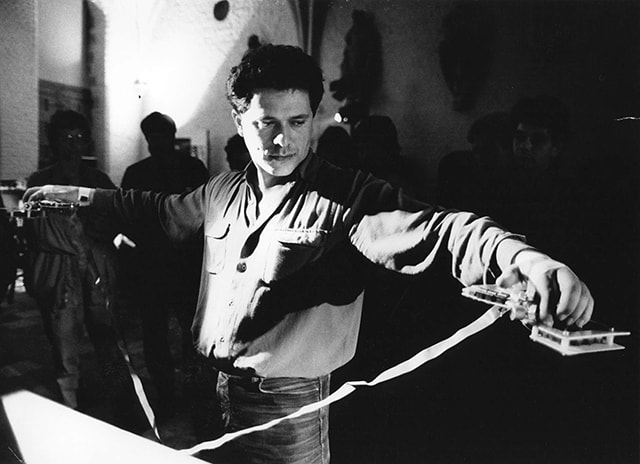title
The Hands
artist
Michel Waisvisz
intro
The Hands (1984) is a digital musical instrument, essentially a MIDI controller, that consists of two controllers that can be attached to one’s hands. A mini keyboard, with a number of sensors and keys, is placed in each of the controllers, which allow the movements of the hands, arms, and fingers to be translated into sounds. Or, in Waisvisz’ words, to ‘touch’ sound.1
It was the release of the MIDI (Musical Instrument Digital Interface) standard in the early 1980s which enabled Waisvisz to create The Hands. His aim was to liberate the performer from the the heavy, static equipment that electronic music performers usually had to work with. The Hands allowed the performer to move freely and to develop a profoundly physical (tactile) relationship between musician and instrument.
The Hands became Waisvisz’ primary instrument and over the years he became a virtuoso in interacting with his invention. He performed both solo and collaborated with numerous other musicians and artists worldwide. As The Hands is capable of creating and manipulating sound, it was an excellent means for free improvisational performances, while also lending itself to the execution of symphonies. Waisvisz conducted various pieces for The Hands, including “Touch Monkeys” (1986) and “The Archaic Symphony” (1987).
biography artist
Michel Waisvisz (The Netherlands, 1949-2008) was a pioneering sound performer and composer. He invented a number of electronic musical instruments, of which the Cracklebox (“Kraakdoos”, 1974) and The Hands (“De Handen”, 1984) are well-known examples. Waisvisz was the artistic director of STEIM, studio for electro-instrumental music, in Amsterdam for 27 years.
keywords
music, electronic music, electronic art, instrument, performance, Digital Musical Instrument (DMI), improvisation, STEIM, sound art
images
[caption id="attachment_415" align="alignnone" width="640"] Michel Waisvisz, The Hands, 1984. Copyright Michel Waiszvisz / crackle.org. [http://www.crackle.org/The%20Hands%201984.htm][/caption][caption id="attachment_414" align="alignnone" width="640"]
Michel Waisvisz, The Hands, 1984. Copyright Michel Waiszvisz / crackle.org. [http://www.crackle.org/The%20Hands%201984.htm][/caption][caption id="attachment_414" align="alignnone" width="640"] Michel Waisvisz, The Hands, 1984. Copyright Michel Waiszvisz / crackle.org. [http://steim.org/archive/Michel/images/mw-hands-1.jpg][/caption]
Michel Waisvisz, The Hands, 1984. Copyright Michel Waiszvisz / crackle.org. [http://steim.org/archive/Michel/images/mw-hands-1.jpg][/caption]
 Michel Waisvisz, The Hands, 1984. Copyright Michel Waiszvisz / crackle.org. [http://www.crackle.org/The%20Hands%201984.htm][/caption][caption id="attachment_414" align="alignnone" width="640"]
Michel Waisvisz, The Hands, 1984. Copyright Michel Waiszvisz / crackle.org. [http://www.crackle.org/The%20Hands%201984.htm][/caption][caption id="attachment_414" align="alignnone" width="640"] Michel Waisvisz, The Hands, 1984. Copyright Michel Waiszvisz / crackle.org. [http://steim.org/archive/Michel/images/mw-hands-1.jpg][/caption]
Michel Waisvisz, The Hands, 1984. Copyright Michel Waiszvisz / crackle.org. [http://steim.org/archive/Michel/images/mw-hands-1.jpg][/caption]
year
1984-2000
premiere
1984, Concertgebouw Amsterdam
software
LiSa
functionality
The data gloves are attached to the performer’s hands. By touching the sensors on the gloves and pushing the keys on the mini keyboard in the glove, the performer can create sound effects. The MIDI codes are translated via analogue signal to a synthesizer or multiple synthesizers. In later versions the synthesizer was replaced by a computer, which the performer wears on his back. This computer can be programmed for every performance.
part of collection
The STEIM archives preserve the last LiSa patch developed by Waisvisz for version 3 of The Hands, named “Thisisit.”
production
Over a period of 25 years, The Hands has been reprogrammed and rebuilt numerous times. The original 1984 prototype was developed by Michel Waisvisz. Later on he collaborated with engineers and programmers at STEIM for further adaptations to the production design and interaction. Three versions of The Hands have been produced (respectively released in 1984, 1990, and 2000)—for each of the versions, the tools and design were updated and the amount of sensors was increased.
hardware
DX7 MIDI synthesizer, MIDI splitter, pitch keys, potentiometer, ultrasonic transmitter, ultrasonic receiver, mercury switches, MIDI controller (1984).
In later versions, the synthesizer was replaced by a computer (The SensorLab) and LiSa software was implemented.
technical specs
The Hands is a wired instrument, connecting a sensory device to a synthesizer (1984 version).
intention artistquote by artist
quote
Waisvisz’s aim was to create an easy-to-build, affordable, portable musical instrument that allowed for live performances and which liberated the electronic musician from the immobile, heavy equipment that he or she had to work with (especially at the time of The Hands’ creation). As Waisvisz stated: “At that time I was on a quest to create electronic music in its purest sense. With its own sonic rules and a narrative purely expressed through sequences of flow, rhythm and sound. What was needed was an instrument that would allow you to 'touch' sound. I wanted to operate, navigate, compose, mold and play sound in a sensible, refined and even sensual and groovy way! Something that was, at that time, not associated with electronic music at all!”2
Waisvisz believed that the magic of a performance could only be communicated live, not in a recording (Waisvisz 1999)3.
“After having experimented many years with a great variety of ways to design and play electronic music instruments in a musical way, by making the electronics literally touchable and mobile ( . . . ), the emergence of MIDI in 1984 provided an excellent way to create new electronic instruments that would be revolutionary, easy to build, portable, affordable and playable on stage. MIDI suddenly allowed me to think of mini-keyboards, fitted to my hands and littered with various movement sensors to translate hand, arm and finger movements immediately into sounds. It would make it possible to trigger and manipulate sounds, but also to conduct streams of sounds. Also I would be able to walk, move and even dance while making electronic music. This was such a liberating prospect after having had to work with big chunks of unmovable analog electronica tied up in the early electronic music studios. Also I experienced that the early synthesizers didn't bring the real grip on electronic sound. Beautiful promising electronic sound worlds were hidden in these instruments, but fitted with traditional organ/piano keyboards they seemed better suited for melodic music than for 'sound-music'. At that time I was on a quest to create electronic music in its purest sense. With its own sonic rules and a narrative purely expressed through sequences of flow, rhythm and sound. What was needed was an instrument that would allow you to 'touch' sound. I wanted to operate, navigate, compose, mold and play sound in a sensible, refined and even sensual and groovy way! Something that was, at that time, not associated with electronic music at all!”
influence
Influenced by, amongst others, artist Dick Raaijmakers and composer Misha Mengelberg.
Influenced contemporary sound artists like Gert-Jan Prins.
LITERATURE
Oskamp, Jacqueline. Onder Stroom: Geschiedenis Van De Elektronische Muziek in Nederland. Ambo, 2011.
Torre, Giuseppe, Kristina Andersen and Frank Baldé. “The Hands: The Making of a Digital Instrument.” Computer Music Journal, vol. .40, no. 2, summer 2016, pp. 22-34, mitpressjournals.org.
Waisvisz, Michel. “The Hands, a Set of Remote MIDI Controllers.” Proceedings of the International Computer Music Conference, 1985, pp. 313–318.
Waisvisz, Michel. “Riding the Sphinx — Lines about ‘Live.” Contemporary Music Review, vol. 18, no. 3, 1999, pp. 119–126.
part of active discussion
scene artists institutes
STEIM, electronic arts/ music, New Interfaces for Musical Expression (NIME) community, impro scene, free improv music scene Amsterdam, free expression, theatre (Moniek Toebosch) ‘New Dutch Swing’
footnote
1 Waisvisz often spoke about music and his instruments in terms of tactility and touch. Detailed information can be found here: Michel Waisvisz, “The CrackleBox ('75).” Crackle.org - Cracklebox, crackle.org.
2 Michel Waisvisz, “The Hands.” Crackle.org - Cracklebox, crackle.org.
3 Michel Waisvisz. “Riding the Sphinx — Lines about ‘Live.’” Contemporary Music Review, vol. 18, no. 3, 1999, pp. 119–126.
4 Michel Waisvisz, “The Hands.” Crackle.org - Cracklebox, crackle.org.
Annie Abrahams
Livinus van de Bundt & Jeep van de Bundt
Driessens & Verstappen (Erwin Driessens and Maria Verstappen)
Yvonne le Grand
Edward Ihnatowicz
JODI (Joan Heemskerk & Dirk Paesmans)
Bas van Koolwijk
Lancel/Maat (Karen Lancel and Hermen Maat)
Jan Robert Leegte
Peter Luining
Martine Neddam
Marnix de Nijs and Edwin van der Heide
Dick Raaijmakers
Joost Rekveld
Remko Scha
Jeffrey Shaw
Debra Solomon
Steina
Peter Struycken
Michel Waisvisz